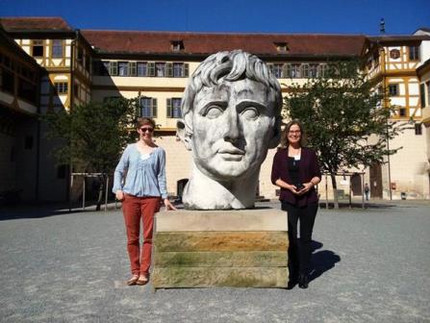DFG Pronoun Project
Syntactic and discourse-level constraints in native and non-native pronoun resolution
Supported by the DFG (2014-2018)
Project staff
Claudia Felser (principal investigator)
Clare Patterson (post-doctoral investigator, 2014-2017)
Janna Drummer (doctoral student)
Cecilia Puebla Antunes (doctoral student)
Project outline
Establishing referential links between pronouns and their antecedents as quickly and as accurately as possible is vital for successful sentence and discourse comprehension. Yet the nature of the mental mechanisms involved, and the types of constraint which guide the antecedent search, are still not fully understood. Both linguistic and psycholinguistic models of anaphor resolution have almost exclusively been informed by data from adult native speakers, and the majority of online processing studies have investigated English. Current hypotheses about the time-course of pronoun resolution differ with regard to the questions of when during processing syntactic and discourse-level constraints come into play, and how they interact over time. This project will investigate and compare the timing of syntactic and discourse-level constraints during native and non-native pronoun resolution in German, with the aim of testing the cross-linguistic and cross-population validity of current theoretical models and hypotheses about real-time anaphor resolution. Data from native and non-native speakers will be compared in order to test the robustness of, and help improve, existing models of anaphor resolution.
Project-related publications
Cunnings, I., Patterson, C., & Felser, C. (2015). Structural constraints on pronoun binding and coreference: Evidence from eye movements during reading. Frontiers in Psychology 6:840. doi:10.3389/fpsyg.2015.00840
Drummer, J.-D., & Felser, C. (2018). Cataphoric pronoun resolution in native and non-native sentence comprehension. Journal of Memory and Language 101, 97-113. doi: 10.1016/j.jml.2018.04.001
Drummer, J.-D., & Felser, C. (2023). Connectivity effects in pseudoclefts in L1 and L2 speakers of German. Second Language Research. doi: 10.1177/02676583221141314
Felser, C. (2016). Binding and coreference in non-native language processing. In Anke Holler & Katja Suckow (eds.), Empirical perspectives on anaphora resolution. Berlin, Boston: De Gruyter Mouton, 229-253.
Felser, C. (2018). Verarbeitung von Pronomen bei erwachsenen L2-Lernern. In S. Schimke & H. Hopp (eds.), Sprachverarbeitung in der Zweitsprache. Berlin: Mouton de Gruyter, 195-220. doi: 10.1515/9783110456356-009
Felser, C., & Drummer, J.-D. (2017). Sensitivity to crossover constraints during native and non-native pronoun resolution. Journal of Psycholinguistic Research 46, 771-789. doi: 10.1007/s10936-016-9465-8
Felser, C., & Drummer, J.-D. (2022). Binding out of relative clauses in native and non-native sentence comprehension. Journal of Psycholinguistic Research 51, 763–788. doi: 10.1007/s10936-022-09845-z
Patterson, C., Esaulova, Y., & Felser, C. (2017). The impact of focus on pronoun resolution in native and non-native sentence comprehension. Second Language Research 33, 403–429. doi: 10.1177/0267658317697786
Patterson, C., & Felser, C. (2019). Delayed application of binding condition C during cataphoric pronoun resolution. Journal of Psycholinguistic Research 48, 453-475. doi: 10.1007/s10936-018-9613-4
Patterson, C., & Felser, C. (2020). Cleft focus and antecedent accessibility within the discourse unit: Evidence from eye movements during reading. In A. Holler, K. Suckow, & I. de la Fuente (eds.) Information structuring in discourse. Leiden: Brill, 56-85.
Puebla, C., & Felser, C. (2022). Discourse prominence and antecedent mis-retrieval during native and non-native pronoun resolution. Discours 29. [LINK]
Puebla, C., & Felser, C. (2023). Discourse-based pronoun resolution in non-native sentence processing. Bilingualism: Language and Cognition. doi: 10.1017/S1366728923000676
Puebla, C., Patterson, C, & Felser, C. (2021). The timing of interference effects during native and non-native pronoun resolution. In V. Torrens (ed.). Syntax processing(pp. 171-199). Newcastle upon Tyne: Cambridge Scholars Publishing.


